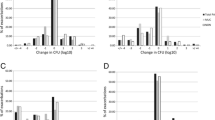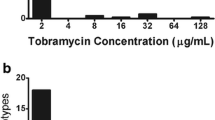Abstract
Our objective was to describe the natural history of infection with transmissible and unique strains of P. aeruginosa (PA) in adult CF patients and to determine if clearance of PA from sputum was associated with an improvement in clinical status. This was a 3-year prospective cohort study of adult patients with CF. Sputum was collected at baseline and annually. Rate of decline of FEV1, BMI, exacerbation rate, and time to death or transplant were compared between patients who cleared PA versus those in whom PA was persistent. A total of 373 patients were included in the study, 75% were infected with PA at baseline; 24% were infected with transmissible strains and 51% with unique strains. Patients infected with unique strains were more likely to clear PA from their sputum over 3 years compared to those infected with transmissible strains (19% vs 10%, P = 0.05). Declines in FEV1 and rates of pulmonary exacerbations, deaths, or lung transplants were not different between patients who cleared PA compared to those who remained persistently infected. No clinical benefit was identified in patients who cleared PA from sputum compared to those who remained persistently infected.





Similar content being viewed by others
References
Gilligan PH (1991) Microbiology of airway disease in patients with cystic fibrosis. Clin Microbiol Rev 4(1):35–51
Corey M, Farewell V (1996) Determinants of mortality from cystic fibrosis in Canada, 1970–1989. Am J Epidemiol 143(10):1007–1017
Emerson J, Rosenfeld M, McNamara S, Ramsey B, Gibson RL (2002) Pseudomonas aeruginosa and other predictors of mortality and morbidity in young children with cystic fibrosis. Pediatr Pulmonol 34(2):91–100
Aaron SD, Vandemheen KL, Ramotar K et al (2010) Infection with transmissible strains of Pseudomonas aeruginosa and clinical outcomes in adults with cystic fibrosis. JAMA 304(19):2145
Al-Aloul M, Crawley J, Winstanley C et al (2004) Increased morbidity associated with chronic infection by an epidemic Pseudomonas aeruginosa strain in CF patients. Thorax 59(4):334–336
Cheng K, Smyth RL, Govan JR et al (1996) Spread of beta-lactam-resistant Pseudomonas aeruginosa in a cystic fibrosis clinic. Lancet 348(9028):639–642
Jones AM, Dodd ME, Morris J et al (2010) Clinical outcome for cystic fibrosis patients infected with transmissible pseudomonas aeruginosa: an 8-year prospective study. Chest 137(6):1405–1409
Gibson RL, Burns JL, Ramsey BW (2003) Pathophysiology and management of pulmonary infections in cystic fibrosis. Am J Respir Crit Care Med 168(8):918–951
Frederiksen B, Koch C (1997) Antibiotic treatment of initial colonization with Pseudomonas aeruginosa postpones chronic infection and prevents deterioration of pulmonary function in cystic fibrosis. Pediatr Pulmonol 23(5):330–335
Ratjen F, Munck A, Kho P, Angyalosi G (2010) Treatment of early Pseudomonas aeruginosa infection in patients with cystic fibrosis: the ELITE trial. Thorax 65(4):286–291
Crapo R, Morris A (1981) Reference spirometric values using techniques and equipment that meet ATS recommendations. Am Rev Respir Dis 123(6):659–664
Altman E, Wang Z, Aaron SD et al (2009) Epidemiological investigation and glycotyping of clinical Pseudomonas aeruginosa isolates from patients with cystic fibrosis by mass spectrometry: association with multiple drug resistance. J Microbiol Methods 76(2):204–208
Beaudoin T, Aaron SD, Giesbrecht-Lewis T, Vandemheen K, Mah TF (2010) Characterization of clonal strains of Pseudomonas aeruginosa isolated from cystic fibrosis patients in Ontario, Canada. Can J Microbiol 56(7):548–557
Ojeniyi B, Høiby N, Rosdahl VT (1991) Prevalence and persistence of polyagglutinable Pseudomonas aeruginosa in isolates from cystic fibrosis patients. APMIS 99(2):187–195
Hoiby N, Koch C (1990) Cystic fibrosis. 1. Pseudomonas aeruginosa infection in cystic fibrosis and its management. Thorax 45(11):881–884
Permin H, Koch C, Høiby N et al (1983) Ceftazidime treatment of chronic Pseudomonas aeruginosa respiratory tract infection in cystic fibrosis. J Antimicrob Chemother 12(Suppl A3):313–323
Rogers GB, Skelton S, Serisier DJ, van der Gast CJ, Bruce KD (2010) Determining cystic fibrosis-affected lung microbiology: comparison of spontaneous and serially induced sputum samples by use of terminal restriction fragment length polymorphism profiling. J Clin Microbiol 48(1):78–86
Aaron SD, Kottachchi D, Ferris WJ et al (2004) Sputum versus bronchoscopy for diagnosis of Pseudomonas aeruginosa biofilms in cystic fibrosis. Eur Respir J 24(4):631–637
Taccetti G, Campana S, Festini F, Mascherini M, Döring G (2005) Early eradication therapy against Pseudomonas aeruginosa in cystic fibrosis patients. Eur Respir J 26(3):458–461
Acknowledgements
Author Contributions
Dr. Burkett is the guarantor and contributed to the data analysis, interpretation, and writing of the manuscript.
Ms. Vandemheen contributed to the study design, data collection, and writing of the manuscript.
Ms. Giesbrecht-Lewis contributed to the data collection, and writing of the manuscript.
Dr. Ramotar contributed to the study design, data collection, interpretation, and writing of the manuscript.
Ms. Ferris contributed to the data collection, and writing of the manuscript.
Dr. Chan contributed to the data collection and writing of the manuscript.
Mr. Doucette contributed to the data analysis and writing of the manuscript.
Dr. Fergusson contributed to the data analysis and writing of the manuscript.
Dr. Aaron is the lead investigator, corresponding author, and contributed to the study design, data collection, analysis, interpretation, and writing of the manuscript.
Financial/nonfinancial disclosures
None.
Funding Source
Funded by Canadian Institutes of Health Research, The Canadian Cystic Fibrosis Foundation and The Ontario Thoracic Society.
Author information
Authors and Affiliations
Corresponding author
Additional information
How does this advance the field? This is the first study to examine clearance of P. aeruginosa from sputa of patients with cystic fibrosis and its relationship to patients’ clinical status.
What are the clinical implications? This study suggests that changes in P. aeruginosa sputum culture status may not reliably predict an improvement in clinical status.
Electronic supplementary material
Below is the link to the electronic supplementary material.
ESM 1
(DOC 31 kb)
Rights and permissions
About this article
Cite this article
Burkett, A., Vandemheen, K.L., Giesbrecht-Lewis, T. et al. Persistency of Pseudomonas aeruginosa in sputum cultures and clinical outcomes in adult patients with cystic fibrosis. Eur J Clin Microbiol Infect Dis 31, 1603–1610 (2012). https://doi.org/10.1007/s10096-011-1483-8
Received:
Accepted:
Published:
Issue Date:
DOI: https://doi.org/10.1007/s10096-011-1483-8




